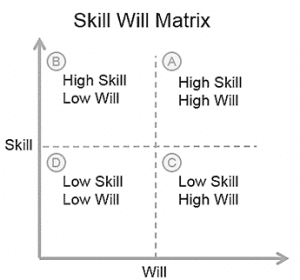This incredibly simplistic 4-box model helps you categorise your team members to better understand what you need to adopt, or maintain, to be the best.
First, determine your team’s WILL – This is the ‘Activity’ i.e. calls, client visits or, where appropriate, emails. The key thing is that it must be client interaction that has some actual value.
Then determine their SKILL – This is conversion of activity into a sale. That gives us our 4 boxes as in the diagram below.

Developing the C’s
The ‘C’s’ (usually newer team members) need a programme to help develop them. It could be an Onboarding / Induction Programme, Mentoring, Shadowing, Sales or Master sales courses, Workbooks, Word tracks and Playbooks, video & audio files or small Lunch & Learn courses. These may even run during sales meetings to keep the focus on learning in the hope that these ‘C’s’ will become ‘A’s’.
A’s, the future leaders
More progressive companies will recognise that the ‘A’s’ are the future leadership and money spinners in the company and realise that they need to be continually nurtured and developed and challenged against other ‘A’s’ or given more responsibility in the organisation along with recognition in order to maintain their ‘A’ status. The danger if this doesn’t happen, is that they could become a ‘B’, i.e. ‘Low Will/High Skill’.
B’s, the good & the bad
So what to do with the most challenging group in the matrix – the ‘B’s’. There are in fact two categories of ‘B’s’. ‘Good B’s’, what I describe as the ‘fallen angels’. They were once good and have now drifted away from the high activity they once put into the job. Often, this occurs because they are still producing good results but the fact that their activity level has reduced goes unnoticed. A switched-on manager would share with them the errors of their ways and put the right incentives in place so they have the desire to become an ‘A’ again!
The other category of ‘B’ is the ‘Bad B’s’. They’re the ones that have been in this category for too long and now feel resentment. It could be because, in their view, there are too many changes that happen too often in the company and so they complain, often! They often speak up on behalf of the poorer performing individuals in the company, highlighting the faults and problems in the marketplace and expanding on all the issues that the company isn’t doing for them. Whilst their intent may be good, they in fact have a detrimental impact on the influential ‘C’s’ (and other categories for that matter) around them!
Dealing with the D’s
And what about the ‘D’s’? Well you may have your own thoughts about them. I hear people suggesting they need to be dismissed. Is that fair? You need to look at why they are in that box. Is it the company’s fault for providing that environment in the first place? I’ll let you decide.
In a ‘B’ led environment, the ‘C’s’ can develop their skill and become a ‘B’, bypassing the ‘A’. However, if they don’t pick it up quickly, eventually they’ll become a ‘D’!
No doubt, as you read this, you thought about members of your team that fit into each category. Why not take it one step further and formally consider each team member within this matrix and work with them to develop the right next step. You could even share this with your colleagues in other departments as it applies to all people in your company and not just the sales team!
Stuart Lotherington, Senior Partner
If you’d like to discuss more about understanding your team to better manage your people, why not get in touch on +44 (0) 20 7653 3740 or info@sbrconsulting.com